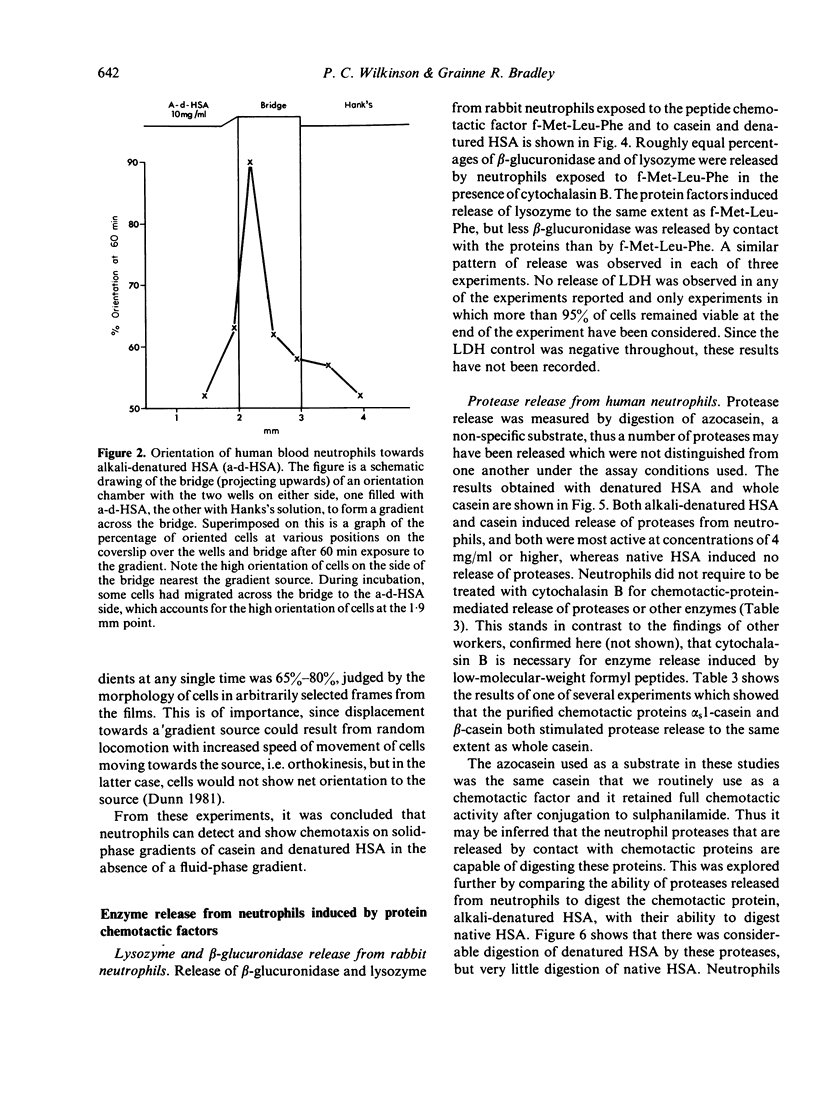Abstract
The purified amphipathic proteins, alpha s 1-casein, beta-casein, and alkali-denatured serum albumin were studied for chemotactic and enzyme-releasing effects on human neutrophil leucocytes. Evidence for chemotaxis both in fluid-phase gradients and on solid-phase gradients was obtained using visual assays. In fluid-phase gradients, neutrophils showed good orientation to gradient sources of these proteins at concentrations of 10(-4) to 10(-5) M. Solid-phase gradients of casein and of denatured albumin were prepared on glass coverslips, and the locomotion of neutrophils attached to these coverslips was filmed by time-lapse cinematography. Displacement of neutrophils towards the highest concentration of substratum-bound protein was observed, suggesting that neutrophils can show true chemotaxis on a solid-phase gradient. All three proteins induced enzyme release from neutrophils in the absence of cytochalasin B. Lysozyme release was equivalent to that released by stimulation with formyl methionyl peptide in the presence of cytochalasin B, but the proteins stimulated a smaller release of beta-glucuronidase than the peptide. The proteins stimulated release of neutrophil proteases which were able to digest both casein and denatured albumin extracellularly. It is suggested that this proteolytic activity may assist locomotion of neutrophils, especially on solid-phase protein gradients, by cleaving membrane-attached protein, thus both freeing cell-surface receptors and allowing the cell to detach itself from the substratum and continue movement.
Full text
PDF











Images in this article
Selected References
These references are in PubMed. This may not be the complete list of references from this article.
- Allan R. B., Wilkinson P. C. A visual analysis of chemotactic and chemokinetic locomotion of human neutrophil leucocytes. Use of a new chemotaxis assay with Candida albicans as gradient source. Exp Cell Res. 1978 Jan;111(1):191–203. doi: 10.1016/0014-4827(78)90249-5. [DOI] [PubMed] [Google Scholar]
- Carter S. B. Haptotaxis and the mechanism of cell motility. Nature. 1967 Jan 21;213(5073):256–260. doi: 10.1038/213256a0. [DOI] [PubMed] [Google Scholar]
- Dierich M. P., Wilhelmi D., Till G. Essential role of surface-bound chemoattractant in leukocyte migration. Nature. 1977 Nov 24;270(5635):351–352. doi: 10.1038/270351a0. [DOI] [PubMed] [Google Scholar]
- Goldstein I., Hoffstein S., Gallin J., Weissmann G. Mechanisms of lysosomal enzyme release from human leukocytes: microtubule assembly and membrane fusion induced by a component of complement. Proc Natl Acad Sci U S A. 1973 Oct;70(10):2916–2920. doi: 10.1073/pnas.70.10.2916. [DOI] [PMC free article] [PubMed] [Google Scholar]
- Henson P. M., Johnson H. B., Spiegelberg H. L. The release of granule enzymes from human neutrophils stimulated by aggregated immunoglobulins of different classes and subclasses. J Immunol. 1972 Dec;109(6):1182–1192. [PubMed] [Google Scholar]
- Keller H. U., Wissler J. H., Ploem J. Chemotaxis is not a special case of haptotaxis. Experientia. 1979 Dec 15;35(12):1669–1671. doi: 10.1007/BF01953261. [DOI] [PubMed] [Google Scholar]
- Magnusson K. E., Stendahl O., Tagesson C., Edebo L., Johansson G. The tendency of smooth and rough Salmonella typhimurium bacteria and lipopolysaccharide to hydrophobic and ionic interaction, as studied in aqueous polymer two-phase systems. Acta Pathol Microbiol Scand B. 1977 Jun;85(3):212–218. doi: 10.1111/j.1699-0463.1977.tb01698.x. [DOI] [PubMed] [Google Scholar]
- Ohlsson K., Olsson I., Spitznagel K. Localization of chymotrypsin-like cationic protein, collagenase and elastase in azurophil granules of human neutrophilic polymorphonuclear leukocytes. Hoppe Seylers Z Physiol Chem. 1977 Mar;358(3):361–366. doi: 10.1515/bchm2.1977.358.1.361. [DOI] [PubMed] [Google Scholar]
- REEVES W. J., Jr, FIMOGNARI G. M. AN IMPROVED PROCEDURE FOR THE PREPARATION OF CRYSTALLINE LACTIC DEHYDROGENASE FROM HOG HEART. J Biol Chem. 1963 Dec;238:3853–3858. [PubMed] [Google Scholar]
- Ribadeau Dumas B., Brignon G., Grosclaude F., Mercier J. C. Structure primaire de la caséine beta bovine. Séquence complète. Eur J Biochem. 1972 Feb;25(3):505–514. doi: 10.1111/j.1432-1033.1972.tb01722.x. [DOI] [PubMed] [Google Scholar]
- SHUGAR D. The measurement of lysozyme activity and the ultra-violet inactivation of lysozyme. Biochim Biophys Acta. 1952 Mar;8(3):302–309. doi: 10.1016/0006-3002(52)90045-0. [DOI] [PubMed] [Google Scholar]
- Showell H. J., Freer R. J., Zigmond S. H., Schiffmann E., Aswanikumar S., Corcoran B., Becker E. L. The structure-activity relations of synthetic peptides as chemotactic factors and inducers of lysosomal secretion for neutrophils. J Exp Med. 1976 May 1;143(5):1154–1169. doi: 10.1084/jem.143.5.1154. [DOI] [PMC free article] [PubMed] [Google Scholar]
- Smith R. P., Lackie J. M., Wilkinson P. C. The effects of chemotactic factors on the adhesiveness of rabbit neutrophil granulocytes. Exp Cell Res. 1979 Aug;122(1):169–177. doi: 10.1016/0014-4827(79)90571-8. [DOI] [PubMed] [Google Scholar]
- Venge P. Kinetic studies of cell migration in a modified Boyden chamber: dependence on cell concentration and effects of the chymotrypsin-like cationic protein of human granulocytes. J Immunol. 1979 Apr;122(4):1180–1184. [PubMed] [Google Scholar]
- Wilkinson P. C., Allan R. B. Binding of protein chemotactic factors to the surfaces of neutrophil leukocytes and its modification with lipid-specific bacterial toxins. Mol Cell Biochem. 1978 Jun 15;20(1):25–40. doi: 10.1007/BF00229452. [DOI] [PubMed] [Google Scholar]
- Wilkinson P. C., Allan R. B. Chemotaxis of neutrophil leukocytes towards substratum-bound protein attractants. Exp Cell Res. 1978 Dec;117(2):403–412. doi: 10.1016/0014-4827(78)90153-2. [DOI] [PubMed] [Google Scholar]
- Wilkinson P. C. Characterization of the chemotactic activity of casein for neutrophil leucocytes and macrophages. Experientia. 1972 Sep 15;28(9):1051–1052. doi: 10.1007/BF01918666. [DOI] [PubMed] [Google Scholar]
- Wilkinson P. C. Effects of human IgG on locomotion of human neutrophils related to IgG binding of a hydrophobic probe. Immunology. 1980 Oct;41(2):457–466. [PMC free article] [PubMed] [Google Scholar]
- Wilkinson P. C. Surface and cell membrane activities of leukocyte chemotactic factors. Nature. 1974 Sep 6;251(5470):58–60. doi: 10.1038/251058a0. [DOI] [PubMed] [Google Scholar]
- Zigmond S. H. Ability of polymorphonuclear leukocytes to orient in gradients of chemotactic factors. J Cell Biol. 1977 Nov;75(2 Pt 1):606–616. doi: 10.1083/jcb.75.2.606. [DOI] [PMC free article] [PubMed] [Google Scholar]
- Zigmond S. H., Hirsch J. G. Leukocyte locomotion and chemotaxis. New methods for evaluation, and demonstration of a cell-derived chemotactic factor. J Exp Med. 1973 Feb 1;137(2):387–410. doi: 10.1084/jem.137.2.387. [DOI] [PMC free article] [PubMed] [Google Scholar]
- Zigmond S. H. Mechanisms of sensing chemical gradients by polymorphonuclear leukocytes. Nature. 1974 May 31;249(456):450–452. doi: 10.1038/249450a0. [DOI] [PubMed] [Google Scholar]



